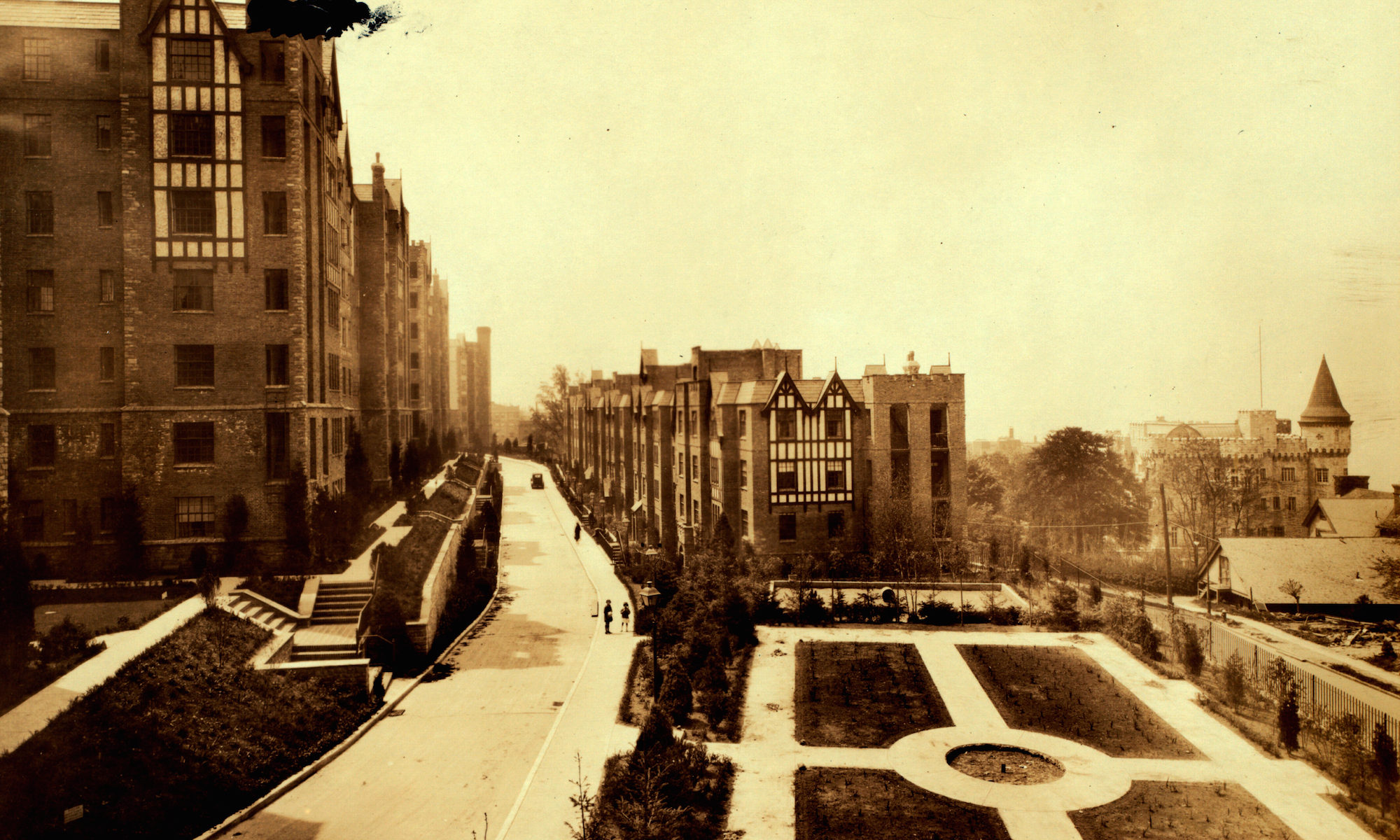“Two years ago Mr. Navin, who is an architect and garden designer, bought a high-floor apartment at 120 Cabrini Boulevard, the southernmost of the Castle Village towers. Filled with architectural artifacts, the apartment has transfixing views of the Hudson, the Palisades and the gardens of Castle Village.
He said that Van Stone, a community activist, first approached him about creating a small park in an empty space up the street at the intersection of Cabrini, 187th and Pinehurst Avenue. Mr. Navin conceived the idea of naming it for Charles Paterno.
”I admire him for the way he made Hudson View Gardens and, later, Castle Village, so responsive to the site, the way the river views are shared with the passersby,” Mr. Navin said, adding that the more typical waterfront development blocks off the water views with walls. Castle Village does not even have a fence at the sidewalk line, an unusually gracious gesture.
Mr. Navin, working with Mr. Stone, put together a proposal for a Paterno Trivium at the 187th Street intersection — ”trivium” means an intersection of roads. Last spring the New York City Parks Department, as part of its Greenstreets Program, created a planted concrete pedestrian island where there had been only bald asphalt.
MR. NAVIN designed the concrete to be scored with radial lines, and the planting consists of Winter King Hawthorn trees that grow to 25 feet, and a ground cover of Cowberry. Both change appearances over the seasons, with flowers, berries and leaves.
The Trivium still looks incomplete, and Mr. Navin has created an organization, the Friends of the Paterno Trivium, to seek funds for additional plantings and benches. He estimated that he needs $10,000 for low, protective hoop fencing and a curved bench. His plan is that the trivium would be a rest stop for elderly shoppers coming up the steep hill from Fort Washington Avenue.
The architectural historian Andrew Dolkart is working on text for a sign. Mr. Navin would also like to make a cast of the medallion bust of Charles Paterno that is on one of the Castle Village buildings and install it in the concrete.
None of the five buildings at the intersection were built by Paterno, but looking down Pinehurst Avenue and Cabrini Boulevard, both Hudson View Gardens and Castle Village are clearly evident.
Tired shoppers stopping at the Paterno Trivium and looking west on 187th Street have a magnificent view of the Palisades, the same view that must have attracted Charles Paterno when he built his unique castle almost a century ago.” Streetscapes/Castle Village and Hudson View Gardens in Upper Manhattan; Shadows of an Uptown Castle, and Its Builder


– Thomas Navin 120 Cabrini Blvd, New York, NY 10033
– Northern Avenue renamed Cabrini Boulevard after Mother Francesca Cabrini, native of Lodi, beatified by Pius XII and called “Heavenly patroness of all emigrants” (Renato Cantore)
– intersection of Cabrini Boulevard, 187th Street, and Pinehurst Avenue
– Friends of the Paterno Trivium, a neighborhood group
– trivium = merging of 3 roads; 300 square feet with 3 wrought iron benches in semicircle
– ribbon cutting ceremony on 4 August 2001 – Carla Paterno Darlington and Mary Faiella Turkus represented the Paterno family at the dedication (Kelley Paterno page 212) – Liz, Bos, and Barratt Dewey were also in attendance
Photos of the Paterno Trivium on Wikipedia
Read the below newspaper article in larger scale HERE on Facebook.






Transcription of above sign:
“PATERNO TRIVIUM .02 acre
This trivium (Latin for a place where three roads meet), at the junction of Cabrini Boulevard, Pinehurst Avenue, and West 187th, is named for Dr. Charles V. Paterno (1877-1946), the person most responsible for the residential development of this section of Fort Washington. The Paterno family arrived in New York from southern Italy and became involved in apartment house construction. Paterno trained as a medical doctor, but after his father’s death in 1899, became an active builder throughout Manhattan. In 1905, he purchased land along the Hudson River, south of 187th Street, and construct a grand mansion know as “Paterno’s Castle.” Paterno acquired additional land in the 1920s, on which he erected the picturesque English Tudor style Hudson View Gardens complex in 1923-24, one of New York City’s earliest middle-class cooperatives. In 1938-39 after moving to Connecticut, Paterno replaced the castle with the Castle Village apartment complex. This series of five building was the first in America to employ the progressive European idea of setting tall residential owners in a park-like setting.
In the Spring of 2000, Paterno Trivium became a Greenstreet site. Greenstreets is a joint project of Parks and Transportation begun in 1986 and revived in 1994. Its goal is to convert paved street properties, such as triangle and malls, into green spaces. Winter King Hawthorn trees (Crataegus viridis) and a ground cover of Cowberry (Vaccinium vitis-idaea magnus) adorn Paterno Trivium.”

The Paterno Trivium: Neighborhood Gathering and Traffic Calming: Hudson Heights, New York City
POSTCARDS FROM THE EDGE OF TOWN
The Paterno Trivium Facebook page


The design of this trivium, including the paving pattern and landscape, was by architect Thomas Navin, AIA, ASLA. The ribbon cutting ceremony that dedicated and named The Paterno Trivium took place on August 4, 2001, the birth date of Dr. Charles V. Paterno. NYC Parks
